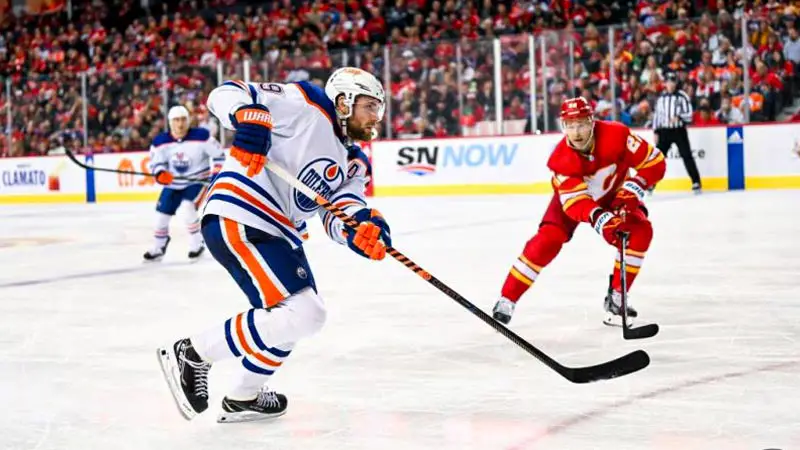Hockey is a sport of speed, skill, and strategy, where every inch of the ice is fiercely contested. One crucial element that often determines the flow and outcome of a game is faceoffs.
Faceoffs Won (FOW) is a pivotal statistic that reflects a team’s ability to gain control of the puck, setting the stage for offensive opportunities or defensive stands.
In this comprehensive guide, we’ll explore the ins and outs of FOW, examining its significance, calculation, strategic implications, and how it shapes the game of hockey.
What does FOW mean in Hockey Stats?
In the realm of hockey statistics, FOW stands for Faceoffs Won. This statistic measures the number of times a player or team successfully gains possession of the puck immediately after a faceoff. It’s a key indicator of puck control and a team’s ability to dictate the pace of play.
Each time the referee drops the puck between two opposing players, it’s a battle for possession, and the team that wins the majority of these battles often gains a strategic advantage.
Importance of FOW in Hockey
Winning faceoffs is far more than a ceremonial puck drop; it’s a critical component of hockey strategy. Possession is key in hockey, and FOW directly translates to puck possession, giving teams the opportunity to initiate plays, control the tempo, and dictate the flow of the game.
Imagine this: Your team has a power play opportunity. Winning the initial faceoff allows your team to set up in the offensive zone, increasing the chances of generating scoring chances and capitalizing on the man advantage.
Conversely, losing the faceoff could lead to the opposing team clearing the puck and negating your power play opportunity.
The impact of FOW extends beyond special teams situations. Consistent faceoff wins contribute to a team’s overall puck possession, influencing both offensive and defensive strategies.
How is FOW Calculated?

Calculating FOW is straightforward. Officials meticulously track every faceoff throughout a game, recording wins and losses for each player and team. Each successful faceoff win is added to the player’s or team’s total FOW count.
To provide a more comprehensive picture of a player’s or team’s effectiveness at faceoffs, FOW is often presented alongside Faceoffs Taken (FOT), which represents the total number of faceoffs participated in.
The Faceoff Win Percentage (FOW%) is then calculated by dividing the number of faceoffs won (FOW) by the total number of faceoffs taken (FOT), providing a clear measure of faceoff success.
Strategies for Winning Faceoffs
Winning a faceoff is a combination of skill, technique, and strategy. Players employ a variety of tactics to gain an edge:
- Quick Wrist Movements: Swift and precise wrist actions are crucial for getting to the puck first.
- Strategic Stick and Body Positioning: Players position their bodies and sticks strategically to leverage strength and reach.
- Reading Opponent Tendencies: Anticipating an opponent’s move can give a player a split-second advantage.
Effective communication and teamwork also play vital roles. Wingers and defensemen coordinate their movements with the center taking the faceoff, aiming to gain possession after the initial puck drop.
Notable Players with High FOW Rates
Okay! In the NHL, faceoff win (FOW) percentage is a key stat for maintaining puck possession and control in big moments. Over the years, players like Patrice Bergeron, Ryan O’Reilly and Claude Giroux have been the best in the business. Here’s why:
1. Patrice Bergeron

He’s a two-way player and has been a faceoff leader for years. His defensive positioning, quick reflexes and hockey sense make him one of the best in the faceoff dot. He ends up above 57% most years, so he’s very precise and experienced in the faceoff circle.
2. Ryan O’Reilly
O’Reilly’s faceoff skills make him one of the most reliable centres in the league. His lower body positioning and hand-eye coordination allow him to outmaneuver opponents. He’s above 55% most years and plays both offensive and defensive zone draws for his team.
3. Claude Giroux
Giroux’s versatility and adaptability have led to high FOW percentages throughout his career and he’s often his team’s FOW leader. His anticipation and speed in the faceoff circle gives him an edge especially in big moments.
FOW and its Impact on Team Strategies
Coaches carefully analyze FOW statistics to develop game plans that capitalize on their team’s strengths and exploit opponent weaknesses.
Effective faceoff specialists are often deployed strategically, particularly in crucial situations like power plays and penalty kills, where gaining or maintaining possession can be game-changing.
Teams may adjust their faceoff strategies based on the opponent they’re facing. If the opposing team has a dominant center, coaches might choose to utilize a defensive strategy, focusing on preventing the opponent from gaining clean possession off the faceoff.
FOW in Fantasy Hockey and Betting
Understanding FOW can be valuable for fantasy hockey enthusiasts and sports bettors. In fantasy hockey, a player’s FOW can be a valuable indicator of their overall effectiveness and contribution to their team.
Players with high FOW% often generate more scoring opportunities and assists, making them desirable assets.
Bettors often consider a team’s FOW percentage as a factor in their decision-making. A team with a consistently high FOW% is more likely to control the pace of play and create scoring chances, potentially influencing the game’s outcome.
How to Improve FOW Stats for Aspiring Players

For aspiring players, mastering the art of faceoffs requires dedication and practice. Here are some tips to improve your FOW stats:
- Practice with Teammates or Coaches: Regular practice sessions focused on faceoff techniques can significantly improve your skills.
- Focus on Quick Reflexes: Develop lightning-fast reflexes to react to the puck drop swiftly.
- Study Successful Faceoff Takers: Analyze the techniques of elite players to identify effective strategies and incorporate them into your game.
Regularly reviewing video recordings of your faceoffs and those of successful players can provide valuable insights into your strengths and weaknesses, allowing you to refine your techniques and develop a winning approach.
The Role of Centers in Faceoffs
Centers play a pivotal role in faceoffs. They are the primary players responsible for engaging in the battle for puck possession, requiring a unique set of skills and attributes:
- Timing and Precision: Centers must react with impeccable timing and precision to gain control of the puck.
- Tactical Awareness: Understanding the situation and anticipating the opponent’s move is crucial for success.
- Communication and Leadership: Centers communicate with their teammates before each faceoff, coordinating strategies to ensure everyone is prepared to react to the outcome.
Skilled centers are adept at adapting their techniques based on the opponent they’re facing. They study their opponent’s tendencies and adjust their approach accordingly, maximizing their chances of winning the draw.
Historical Perspective on FOW
The importance of FOW in hockey has evolved over time. In the early days of the sport, FOW was viewed as a statistic of interest but lacked the in-depth analysis it receives today. The focus was primarily on traditional metrics like goals and assists.
As the sport evolved and statistical analysis became more sophisticated, particularly with the rise of advanced analytics in the late 20th and early 21st centuries, the significance of FOW became increasingly apparent.
Teams realized that controlling faceoffs could directly translate to controlling the game tempo and, ultimately, winning more games.
Today, FOW is a highly scrutinized statistic, influencing player evaluation, coaching decisions, and game strategies. It’s a testament to the increasing complexity of hockey and the importance of data-driven decision-making in the modern game.
Pro Tips:
- Coaches often tailor their game plans to maximize the strengths of their faceoff specialists. They might adjust lineups based on the opponent’s faceoff prowess and design plays specifically designed to capitalize on faceoff wins.
- The psychological aspect of faceoffs is often overlooked but can be crucial. Players and coaches study their opponents, looking for patterns or tendencies that they can exploit. Anticipating an opponent’s move can provide a decisive edge in the battle for possession.
Frequently Asked Questions (FAQs):
What does a consistently high FOW% indicate about a player?
A high FOW% suggests that a player possesses exceptional skills in gaining possession for their team, providing a valuable strategic advantage.
Can a player improve their FOW% over time?
Absolutely! With dedicated practice, improved reflexes, and a focus on strategy, players can significantly enhance their FOW%.
How important is FOW to a team’s overall strategy?
FOW is a critical element of a team’s strategy, influencing both offensive and defensive approaches. It’s a key factor in dictating game pace and possession, which ultimately impacts the outcome of games.
Where can fans find FOW stats during games?
Fans can readily access FOW statistics through various sources, including sports networks, NHL game broadcasts (often updated in real-time), and official NHL statistics websites.
Is FOW considered when forming fantasy hockey teams?
Yes, FOW is a valuable statistic to consider in fantasy hockey. A player’s FOW% reflects their puck control skills, which can translate to more scoring opportunities and assists.
Conclusion
FOW is a crucial statistic in hockey, offering valuable insights into a team’s ability to control the game. Understanding FOW allows fans, players, and coaches to appreciate the strategic depth this seemingly simple aspect of the game brings.
By analyzing faceoff outcomes, identifying trends, and developing effective strategies, teams can gain a competitive edge on the ice.
Whether you’re a seasoned hockey enthusiast, an aspiring player, or simply curious about the intricacies of the sport, appreciating the role of FOW enhances your understanding and enjoyment of the game.





James Felix